How to Make Home-Canned Mixed Vegetables - Easily! With Step-by-step Directions, Photos, Ingredients, Recipe and Costs
PickYourOwn.org - Find a pick-your-own farm near you! Then learn to can and freeze!
Search pickyourown.org

Looking for How to Make Home-Canned Mixed Vegetables - Easily! With Step-by-step Directions, Photos, Ingredients, Recipe and Costs in 2024? Scroll down this page and follow the links. And if you bring home some fruit or vegetables and want to can, freeze, make jam, salsa or pickles, see this page for simple, reliable, illustrated canning, freezing or preserving directions . There are plenty of other related resources, click on the resources dropdown above. If you are having a hard time finding canning lids, I've used these, and they're a great price & ship in 2 days .
If you have questions or feedback, please let me know ! There are affiliate links on this page. Read our disclosure policy to learn more.
How to Make Home-Canned Mixed Vegetables - Easily! With Step-by-step Directions, Photos, Ingredients, Recipe and Costs
Yield: 7 to 9 pint jars
Click here for a PDF print version
Making and canning your own mixed vegetables is easy and you can use quite a variety of vegetables (with a few exceptions noted in the ingredients section). Typical combinations include carrots, peas, green beans, corn, tomatoes, summer squash, etc.
The only trick is, you really do need a Pressure Canner . Every university food science department and the government will tell you that it just is not safe to use the water bath bath method; it takes the higher temperatures of the pressure canner to kill the botulism bacteria.
See this FAQ for details: Can I use a water-bath canner instead of a Pressure Canner for low acid foods like mixed vegetables, green beans, corn, etc?
BUT, with a Pressure Canner it's easy. And although a Pressure Canner costs $100 to $200 ( see this page for pressure canners models, makes and prices ), they last a lifetime, and your children and grandchildren may be using it. You can also find free information from the USDA in this PDF file (it will take a while to load!) about selecting and using canners here!
Ingredients
Yield: 7 quarts, but you can scale this recipe up or down to suit your needs!
- 6 cups sliced carrots
- 6 cups cut, whole kernel sweet corn
- 6 cups cut green beans
- 6 cups shelled lima beans
- 4 cups whole or crushed tomatoes
- 4 cups diced zucchini
- Optional mix - According to the USDA, you may change the suggested proportions or substitute
other favorite vegetables, such as peas, zucchini, etc;
except for the following: leafy greens (such as spinach, collards, kale, etc.), dried beans, cream-style corn, winter squash and/or sweet potatoes.
Equipment 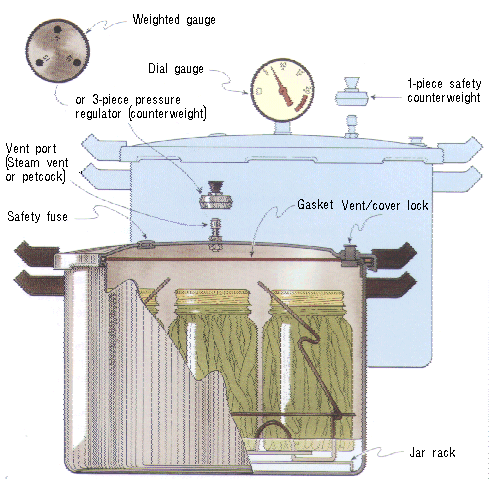
- 1 Pressure Canner (a large pressure pot with a lifting rack to sanitize the jars after filling (about $75 to $200 at mall kitchen stores and "big box" stores, but it is cheaper online; see this page for more information ). For low acid foods (most vegetables, you can't use an open water bath canner, it has to be a Pressure Canner to get the high temperatures to kill the bacteria. If you plan on canning every year, they're worth the investment.
- Jar grabber (to pick up the hot jars)
- Jar funnel ($4 at mall kitchen stores and local "big box" stores, but it's usually cheaper online from our affiliates)
- At least 1 large pot
- Large spoons and ladles ,, knife, cutting board, peeler, etc.
- Canning jars (often called Ball jars, Mason jars or Kerr jars) (Publix, Kroger, other grocery stores and some "big box" stores carry them - now about $12 per dozen quart jars (up 50% in 2 years!) including the lids and rings)
- Salt (optional - I don't use any)
Directions - Step by Step

Step 1 - Prepare the jars and pressure canner
Wash the jars and lids
This is a good time to get the jars ready! The dishwasher is fine for the jars; especially if it has a "sanitize" cycle. Otherwise put the jars in boiling water for 10 minutes. I just put the lids in a small pot of almost boiling water for 5 minutes, and use the magnetic "lid lifter wand" (available from target, other big box stores, and often grocery stores; and available online - see this page) to pull them out.
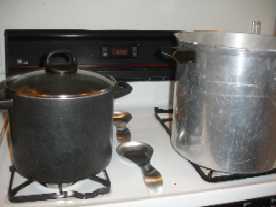
Get the pressure canner heating up
Rinse out your pressure canner, put the rack plate in the bottom, and fill it to a depth of 4 inches with hot tap water. (of course, follow the instruction that came with the canner, if they are different). Put it on the stove over low heat, with the lid OFF of it, just to get it heating up for later on.
Step
2 - Wash the veggies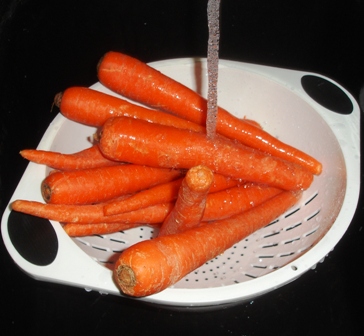
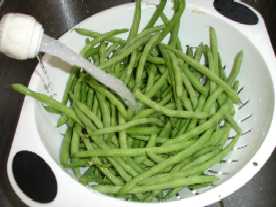
Just wash them under cold running water!
Step 3 - Prepare and dice or slice the veggies
Except for zucchini or other summer squash; wash and prepare the vegetables as appropriate for each vegetable, see below:
"Prepare" means cut out any soft or bruised parts, stems, and inedible portions!
Carrots,
peel and remove ends

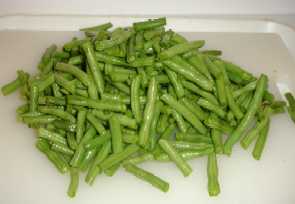
Green beans, cut of ends and slice
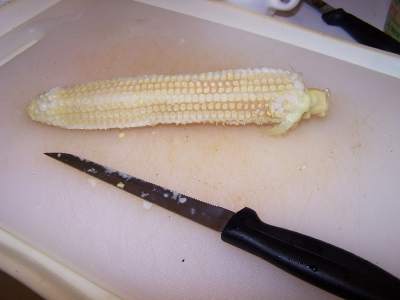
Corn, shuck, de-silk and slice off the cob
See here for related tools, equipment, supplies on Amazon
See here for related tools, equipment, supplies on Amazon
See here for related tools, equipment, supplies on Amazon
And so on for the other veggies. Zucchini: Wash, trim, and slice or cube zucchini.
Dice the vegetables into 1/2 inch (1 cm) sized pieces (approximately, don't measure each!). "Prepare" means cut out any soft or bruised parts, stems, and inedible portions!
Step 4 - Combine in a large pot and boil for 5 minutes
Combine all vegetables in a large pot or kettle, and add enough water to cover pieces. Boil for 5 minutes. (This is a blanching, not cooking step!)
Step 5 - Fill the jars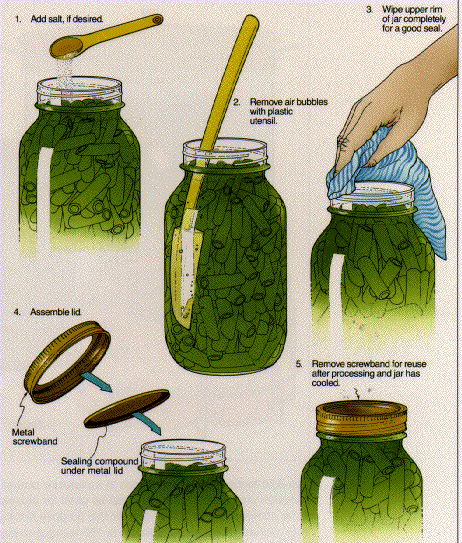
Fill the jars with the hot vegetables pieces, using a slotted spoon. Add hot liquid from the pot, leaving 1-inch headspace. Optional: Add 1 teaspoon salt per quart to the jar, if desired. I don't add any salt, it is not needed to preserve the food; and you can always add it when you open the jars later!
Put the lids on each jar and seal them by putting a ring on and screwing it down snugly (but not with all your might, just "snug").
Step 6 - Put the jars in the canner and the lid on the canner (but still vented)
Using the jar tongs, put the jars on the rack in the canner. By now the water level has probably boiled down to 3 inches. If it is lower than that, add more hot tap water to the canner. When all the jars that the canner will hold are in, put on the lid and twist it into place, but leave the weight off (or valve open, if you have that type of pressure canner).
Step 7 - Let the canner vent steam for 10 minutes 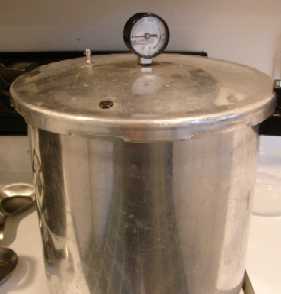
Put the heat on high and let the steam escape through the vent for 10 minutes to purge the airspace inside the canner.
Step 8 - Put the weight on and let the pressure build
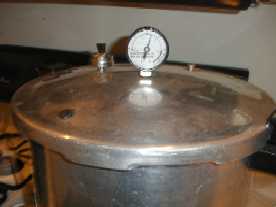 After 10 minutes of venting, put the weight on and close any openings
to allow the pressure to build to 11 pounds.
After 10 minutes of venting, put the weight on and close any openings
to allow the pressure to build to 11 pounds.
Step 9 - Process in the pressure canner for 75 to 90 minutes, see the tables below
Once the gauge hits 10 pounds, start your timer going - for 75 minutes for pint jars, 90 minutes for quart jars. Adjust the heat, as needed, to maintain 10 pounds of pressure.
Note: the tables below will help you determine the right processing time and pressure, if you have a different type of canner, or are above sea level.
It is important to learn how to operate your pressure canner by reading the owner's manual that came with your particular canner. If you cannot find your owner's manual, you can obtain find one online: Here is where to find some common manufacturer's manuals:
or by contacting the company that made your canner. Give the model number to the manufacturer, and they will send you the right manual. Click here for more information about pressure canners and a variety of models you can order .
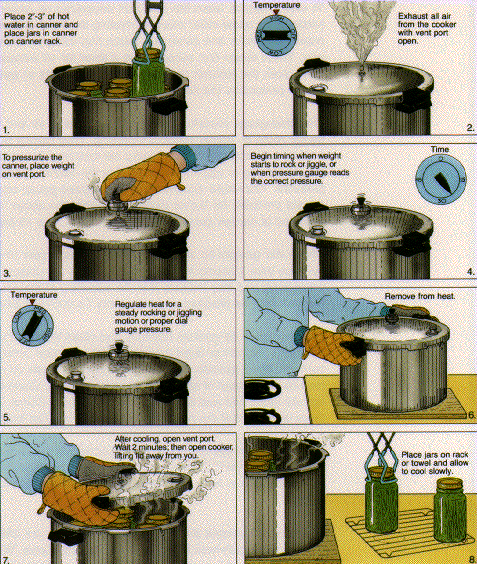
Step 10 - Turn off the heat and let it cool down
When the processing time from the chart above is up, turn off the heat, and allow the pressure canner to cool and the pressure to drop to zero before opening the canner. Let the jars cool without being jostled. After the pressure drops to zero (usually, you can tell but the "click" sound of the safety release vents opening, as well as but the gauge. Let the pressure in the canner drop to zero by itself. This may take 45 minutes in a 16-quart canner filled with jars and almost an hour in a 22-quart canner. If the vent is opened before the pressure drops to zero OR if the cooling is rushed by running cold water over the canner, liquid will be lost from the jars. Too rapid cooling causes loss of liquid in the jars!
Step 11 - Remove the jars
Lift the jars out of the water and let them cool on a wooden cutting board or a towel, without touching or bumping them in a draft-free place (usually takes overnight), here they won't be bumped. You can then remove the rings if you like, but if you leave them on, at least loosen them quite a bit, so they don't rust in place due to trapped moisture. Once the jars are cool, you can check that they are sealed verifying that the lid has been sucked down. Just press in the center, gently, with your finger. If it pops up and down (often making a popping sound), it is not sealed. If you put the jar in the refrigerator right away, you can still use it. Some people replace the lid and reprocess the jar, then that's a bit iffy. If you heat the contents back up, re-jar them (with a new lid) and the full time in the canner, it's usually ok. You're done!
This document was extracted from the "Complete Guide to Home Canning," Agriculture Information Bulletin No. 539, USDA. Reviewed 1994.
Illustrated Canning, Freezing, Jam Instructions and Recipes
[ Easy Home Canning Directions ] [ FAQs - Answers to common questions and problems ] [ Recommended books about home canning, jam making, drying and preserving! ] [ Free canning publications to download and print ]
Looking for canning equipment and supplies?
Water bath canner with a jar rack
Pressure canners for gas, electric and induction stoves : Presto 23Qt or T-fal 22Qt
Canning scoop (this one is PERFECT)
Ball Blue book (most recent version)
Find Other types of farms:
Farm markets and roadside stands
Road trips and camping resources
Local Honey , apiaries, beekeepers
Consumer fraud and scams information
Home canning supplies at the best prices on the internet!
Maple Syrup Farms , sugarworks, maple syrup festivals
Environmental information and resources
Farms For Your Event for birthday parties, weddings, receptions, business meetings, retreats, etc.
Festivals - local fruit and vegetable festivals
Get themost recent version of
the Ball Blue Book
With this Presto 23 quart pressure canner and pressure cooker, you can "can" everything, fruits, vegetables, jams, jellies, salsa, applesauce, pickles, even meats, soups, stews. Model 01781

You can make jams, jellies, can fruit, applesauce, salsa and pickles with water bath canners, like this Granite Ware 12-Piece Canner Kit, Jar Rack, Blancher, Colander and 5 piece Canning Tool Set

This page was updated on
Disclosure: As an Amazon Associate I earn from qualifying purchases.
Want to make a donation? pickyourown.org does not charge either farmers or consumers! I do all of the programming, web design and updates myself. If you'd like to make a donation to help me pay to keep the website going, please make a donation to me at Benivia through our secure donation processor. Just click the button below and follow the instructions:
All images and text
© Copyright Benivia, LLC 2008-2019 Disclaimer
and Privacy Policy
.
Permission is given to link to any page on www.pickyourown.org
but NOT to copy content and republish it. Those copying content from this website and publishing it will be vigorously legally prosecuted.
Sitemap
Local Weather Forecast (Scroll down)
Click the image below for a complete weather forecast.


